Angry bird--it's what's for dinner
William and Mary Dyer arrived in Boston, Massachusetts Bay Colony, in 1635. One of their parcels of land was part of Rumney Marsh, Saugus; later, when they moved to Rhode Island, William was granted Dyer Island in Narragansett Bay. Centuries later, both properties became wildlife refuges, particularly supporting birds. Of course, in the 17th century, there was no thought of conservation or ecological balance; merely "sport" and "Birds--it's what's for dinner."
Of the Birds and Fowles both of Land and Water As observed by William Wood in New Englands Prospect, published in 1634-35 as an advertisement for Englishmen to emigrate to Massachusetts Bay Colony. Annotated by Jo Ann Butler* whose comments are printed in gold.
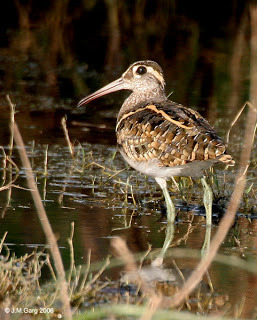 The snipe Having shewed you the most desirable, usefull, and benificiall creatures, with the most offensive carrions that belong to our Wildernesse, it remaines in the next place, to shew you such kinds of Fowle as the Countrey affoords: They are many, and we have much variety both at Sea and on Land; and such as yeeld us much profit, and honest pleasure, and are these that follow; asThe Princely Eagle, and the soaring Hawke, Whom in their unknowne waves there is none can chawke: The Humberd for some Queenes rich Cage more fit, Than in the vacant Wildernesse to Flit. The swift winged Swallow sweeping to and fro, As swift as arrow from Tartarian Bow. Five species of swallow make New England their home. Barn Swallows, with their fondness for building their mud nests on barn rafters, can be observed at close range.When as Aurora's infant day new springs, There the morning mounting Larke her sweete lays sings. There are many types of Lark in Europe, where Woods received his education, but only one in North America. Its song is so thin and tinkly that Woods probably refers to the Eastern Meadowlark. It is more closely related to blackbirds than larks, but has a sweet, cheery morning song.The harmonious Thrush, swift Pigeon, Turtle-dove, Who to her mate doth ever constant prove.The Turky-Pheasant, Heathcocke, Partridge rare, The carrion-tearing Crow, and hurtfull Stare, The long liv'd Raven, the ominous Screech-Owle, Who tells as old wives say, disasters foule. The drowsie Madge that leaves her day-loved nest, And loves to rove when day-birds be at rest. The Eel-murthering Heron, and greedy Cormorant, That neare the Creekes in morish Marshes haunt.
The snipe Having shewed you the most desirable, usefull, and benificiall creatures, with the most offensive carrions that belong to our Wildernesse, it remaines in the next place, to shew you such kinds of Fowle as the Countrey affoords: They are many, and we have much variety both at Sea and on Land; and such as yeeld us much profit, and honest pleasure, and are these that follow; asThe Princely Eagle, and the soaring Hawke, Whom in their unknowne waves there is none can chawke: The Humberd for some Queenes rich Cage more fit, Than in the vacant Wildernesse to Flit. The swift winged Swallow sweeping to and fro, As swift as arrow from Tartarian Bow. Five species of swallow make New England their home. Barn Swallows, with their fondness for building their mud nests on barn rafters, can be observed at close range.When as Aurora's infant day new springs, There the morning mounting Larke her sweete lays sings. There are many types of Lark in Europe, where Woods received his education, but only one in North America. Its song is so thin and tinkly that Woods probably refers to the Eastern Meadowlark. It is more closely related to blackbirds than larks, but has a sweet, cheery morning song.The harmonious Thrush, swift Pigeon, Turtle-dove, Who to her mate doth ever constant prove.The Turky-Pheasant, Heathcocke, Partridge rare, The carrion-tearing Crow, and hurtfull Stare, The long liv'd Raven, the ominous Screech-Owle, Who tells as old wives say, disasters foule. The drowsie Madge that leaves her day-loved nest, And loves to rove when day-birds be at rest. The Eel-murthering Heron, and greedy Cormorant, That neare the Creekes in morish Marshes haunt.
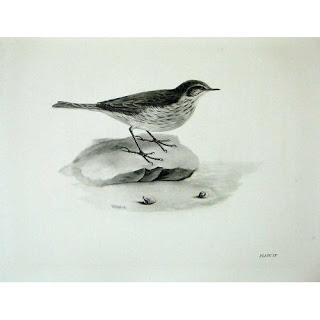 Sea Lark, or American pipitThe bellowing Bitterne, with the long-leg'd Crane, Presaging Winters hard, and dearth of graine. The Silver Swan that tunes her mournefull breath, To sing the dirge of her approaching death. The tailing Oldwives, and the cackling Geese, The fearefull Gull that shunnes the murthering Peece. The strong winged Mallard, with the nimble Teale, And ill-shape't Loone who his harsh notes doth squeale. There Widgins, Sheldrackes and Humilitees,
Snipes
, Doppers, Sea-Larkes, in whole millions flees.
Sea Lark, or American pipitThe bellowing Bitterne, with the long-leg'd Crane, Presaging Winters hard, and dearth of graine. The Silver Swan that tunes her mournefull breath, To sing the dirge of her approaching death. The tailing Oldwives, and the cackling Geese, The fearefull Gull that shunnes the murthering Peece. The strong winged Mallard, with the nimble Teale, And ill-shape't Loone who his harsh notes doth squeale. There Widgins, Sheldrackes and Humilitees,
Snipes
, Doppers, Sea-Larkes, in whole millions flees. The Eagles of the Countrey be of two sorts, one like the Eagles that be in England, the other is something bigger with a great white head, and white tayle: these bee commonly called Gripes; these prey upon Duckes and Geese, and such Fish as are cast upon the Sea-shore. And although an Eagle be counted King of that feathered regiment, yet is there a certaine blacke Hawke that beates him; so that he is constrayned to soare so high, till heate expell his adversary. This Hawke is much prized of the Indians, being accounted a Sagamores ransome.
I’m not sure which of several New England hawks Wood refers to. Golden Eagles do occur in the East, but they aren’t common. I wonder if Wood is speaking of Gyrfalcons? The dark form occurs in the Maritimes and would get down to New England at times. They are spectacular fliers, and might well take food from eagles. The ‘princely eagle’ is our national symbol, the Bald Eagle. We Americans like to depict the bird as a ferocious predator. However, it is mainly a scavenger of fish and waterfowl, and would often be seen on the coast and rivers year-round. The Bald Eagle is one of the best comeback stories in the U.S. Once endangered by DDT contamination, critically so in the East, reintroduced birds are now multiplying.
To speake much of Hawkes, were to trespasse upon my owne judgement, and bring upon my selfe a deserved censure, for abusing the Faulconers termes: But by relation from those that have more insight into them than my selfe: There be divers kinds of Hawkes: their aeries are easie to come by, being in the holes of Rockes, neare the shore, so that any who are addicted to that sport, if he will be but at the charge of finding Poultry for them, may have his desires. We could wish them well mew'd in England, for they make havocke of Hens, Partridges, Heathcockes, and Duckes; often hindering the Fowler of his long look't for shoote.
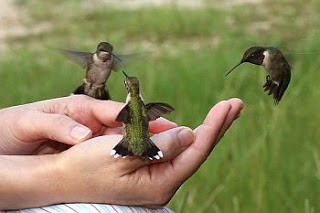 Source: http://friendsofalewifereservation.org/
The Humbird is one of the wonders of the Countrey, being no bigger than a Hornet, yet hath all the dimensions of a Bird, as bill, and wings, with quills, spiderlike legges, small clawes: For colour, she is as glorious as the Raine-bow; as she flies, she makes a little humming noise like a Humble-bee: wherefore she is called the Humbird.
Source: http://friendsofalewifereservation.org/
The Humbird is one of the wonders of the Countrey, being no bigger than a Hornet, yet hath all the dimensions of a Bird, as bill, and wings, with quills, spiderlike legges, small clawes: For colour, she is as glorious as the Raine-bow; as she flies, she makes a little humming noise like a Humble-bee: wherefore she is called the Humbird. The Ruby-throated Hummingbird is the only species found in the Northeast. Hummingbirds are unknown in the Old World, so a caged bird would have been a wonder fit for royalty. Early explorers captured live specimens by squirting a hovering bird with water from a syringe.
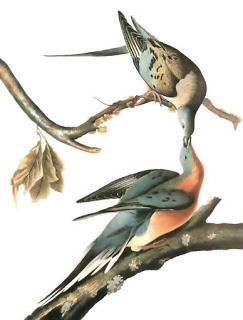 Passenger pigeons, extinct in 1914The Pigeon of that Countrey, is something different from our Dove-house Pigeons in England, being more like Turtles, of the same colour; but they have long tayles like a Magpie: And they seeme not so bigge, because they carry not so many feathers on their backes as our English Doves, yet are they as bigge in body. These Birds come into the Countrey, to goe to the North parts in the beginning of our Spring, at which time (if I may be counted worthy, to be believed in a thing that is not so strange as true) I have seene them fly as if the Aerie regiment had beene Pigeons; seeing neyther beginning nor ending, length, or breadth of these Millions of Millions. The shouting of people, the rattling of Gunnes, and pelting of small shotte could not drive them out of their course, but so they continued for foure or five houres together: yet it must not be concluded, that it is thus often; for it is but at the beginning of the Spring, and at Michaelmas, when they returne backe to the Southward; yet are there some all the yeare long, which are easily attayned by such as looke after them. Many of them build amongst the Pine trees, thirty miles to the North-east of our plantations; joyning nest to nest, and tree to tree by their nests, so that the Sunne never sees the ground in that place, from whence the Indians fetch whole loades of them.
Passenger pigeons, extinct in 1914The Pigeon of that Countrey, is something different from our Dove-house Pigeons in England, being more like Turtles, of the same colour; but they have long tayles like a Magpie: And they seeme not so bigge, because they carry not so many feathers on their backes as our English Doves, yet are they as bigge in body. These Birds come into the Countrey, to goe to the North parts in the beginning of our Spring, at which time (if I may be counted worthy, to be believed in a thing that is not so strange as true) I have seene them fly as if the Aerie regiment had beene Pigeons; seeing neyther beginning nor ending, length, or breadth of these Millions of Millions. The shouting of people, the rattling of Gunnes, and pelting of small shotte could not drive them out of their course, but so they continued for foure or five houres together: yet it must not be concluded, that it is thus often; for it is but at the beginning of the Spring, and at Michaelmas, when they returne backe to the Southward; yet are there some all the yeare long, which are easily attayned by such as looke after them. Many of them build amongst the Pine trees, thirty miles to the North-east of our plantations; joyning nest to nest, and tree to tree by their nests, so that the Sunne never sees the ground in that place, from whence the Indians fetch whole loades of them. The Turtle-Dove is a Eurasian bird, but Woods applies the name to our Mourning Doves, who are indeed devoted mates. His Pigeon is not the familiar Rock Pigeon of city parks. The Passenger Pigeon, similar in appearance to the Mourning Dove, once roved the eastern and central U.S. in gigantic flocks. Awed observers claimed some flocks took days to pass over. They are no more. Market hunting devastated the population, and clearing of their forest habitat ensured their extinction.
The Turky is a very large Bird, of a blacke colour, yet white in flesh; much bigger than our English Turky. He hath the use of his long legs so ready, that he can runne as fast as a Dogge, and flye as well as a Goose: of these sometimes there will be forty, threescore, and a hundred of a flocke, sometimes more and sometimes lesse; their feeding is Acornes, Hawes, and Berries, some of them get a haunt to frequent our English corne: In winter when the Snow covers the ground, they resort to the Sea shore to look for Shrimps, & such small Fishes at low tides. Such as love Turky hunting, must follow it in winter after a new fallen Snow, when he may follow them by their tracts; some have killed ten or a dozen in halfe a day; if they can be found towards an evening and watched where they perch if one come about ten or eleven of the clocke he may shoote as often as he will, they will sit, unlesse they be slenderly wounded. These Turkies remaine all the yeare long, the price of a good Turkie cocke is foure shillings; and he is well worth it, for he may be in weight forty pound; a Hen two shillings. Pheasants bee very rare, but Heathcockes, and Partridges be common; he that is a husband, and will be stirring betimes, may kill halfe a dozen in a morning.
We all know the Turkey, which is indeed a type of pheasant. New England has Ruffed Grouse, and Woods’ Partridge is likely to be the Northern Bobwhite, named for its easily-imitated ‘bob-white’ whistle. The Heathcock is another extinct bird, the Heath Hen. The chicken-like bird once lived on Boston Common and other heathland barrens. The familiar one-two punch of hunting and habitat destruction was joined by predation from feral house cats. Realizing that the suppression of fire in their scrublands contributed to their demise has helped conservationists preserve proper habitat for the Heath Hen’s Prairie-Chicken cousins.
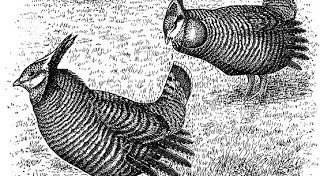 Extinct heath henThe Partridges be bigger than they be in England, the flesh of the Heathcockes is red, and the flesh of a Partridge white, their price is foure pence a peece. The Ravens, and the Crowes be much like them of other countries.
Extinct heath henThe Partridges be bigger than they be in England, the flesh of the Heathcockes is red, and the flesh of a Partridge white, their price is foure pence a peece. The Ravens, and the Crowes be much like them of other countries. There are no Magpies, Jackdaws, Coockooes, Jayes, Sparrows, &c. English house sparrows were introduced to various towns in eastern America in the late 19th century, in an attempt to control insects, but their insect consumption is only about four percent of their diet, the vast majority being grain and seed. Sparrows and starlings now number in the hundreds of millions and have supplanted native songbirds in many areas, from loss of habitat and food sources. Eugene Schieffelin wanted to introduce all the birds mentioned in the plays of William Shakespeare to North America, and he released flocks of sparrows, European starlings, bullfinches, chaffinches, nightingales, and skylarks to breed in the latter half of the 1800s.
The Stares [starlings?] be bigger than those in England, as blacke as Crowes, being the most troublesome, and injurious bird of all others, pulling up the cornes by the roots, when it is young, so that those who plant by reedy and soggy places, where they frequent, are much annoyed with them, they being so audacious that they feare not Guns, or their fellowes hung upon poles; but the Corne having a weeke or nine dayes growth is past their spoyling. The Owles be of two sorts; the one being small speckled, like a Partridge, with eares, the other being a great Owle, almost as big as an Eagle, his body being as good meate as a Partridge.
Screech Owls and Great Horned Owls both have horns, but the former is much smaller. The Greeks may be the last people who thought that hearing an Owl was a good omen. A hooting owl was thought by the Romans to have presaged Julius Caesar’s death. The bird’s call has been thought ominous ever since.
Cormorants bee as common as other fowles, which destroy abundance of small fish, these are not worth the shooting because they are the worst of fowles for meate, tasting ranke, and fishy: againe, one may shoot twenty times and misse, for seeing the fire in the panne, they dive under the water before the shot comes to the place where they were; they use to roost upon the tops of trees, and rockes, being a very heavy drowsie creature, so that the Indians will goe in their Canoes in the night, and take them from the Rockes, as easily as women take a Hen from roost; No ducking ponds can afford more delight than a lame Cormorant, and two or three lusty Dogges.
Personal aside: Aren’t you glad that blood sport is (mostly) outlawed? If you can’t eat ‘em, torture ‘em.
The Crane although he bee almost as tall as a man by reason of his long legges, and necke; yet is his body rounder than other fowles, not much unlike the body of a Turkie. I have seene many of these fowles, yet did I never see one that was fat, I suppose it is contrary to their nature to grow fat; Of these there be many in Summer, but none in winter, their price is two shilling.
The Sandhill Crane is not often found in New England. Perhaps the birds were fleeing drought or flood elsewhere, and New England might expect disrupted weather as well.
There be likewise many Swannes which frequent the fresh ponds and rivers, seldome consorting themselves with Duckes and Geese; these bee very good meate, the price of one is six shillings.
Swans are generally silent, communicating with hisses and honks. The “Swan Song” comes to us from the Greeks, who believed that the bird would finally find its voice with its dying breath. In 1898 D.G. Eliot, a zoologist, reported a swan he had shot uttering “plaintive and musical” notes that “sounded at times like the soft running of the notes of an octave,” so perhaps there is something to the tale after all.
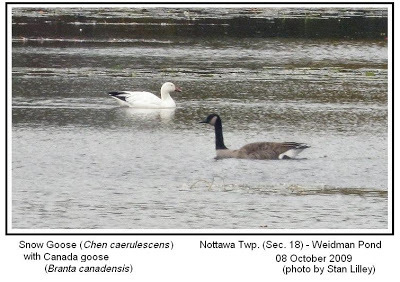 Source: http://stoneplus.cst.cmich.edu/birds/1aSnowGoose.JPG The Geese of the countrey be of three sorts, first a brant Goose, which is a Goose almost like the wilde Goose in England, the price of one of these is six pence. The second kind is a white Goose, almost as big as an English tame Goose, these come in great flockes about Michelmasse, sometimes there will be two or three thousand in a flocke, these continue six weekes, and so flye to the southward, returning in March, and staying six weekes more, returning againe to the Northward; the price of one of these is eight pence. The third kind of Geese, is a great gray Goose, with a blacke necke, and a blacke and white head, strong of flight; these bee a great deale bigger than the ordinary Geese of England, some very fat, and in the Spring so full of Feathers, that the shot can scarce pierce them; most of these Geese remaine with us from Michelmas to Aprill; they feede on the Sea of Fish, and in the woods of Acornes, having as other Foule have, their passe and repasse to the Northward and Southward: the accurate marksmen kill of these both flying and sitting; the price of a good gray Goose is eighteene pence.
Source: http://stoneplus.cst.cmich.edu/birds/1aSnowGoose.JPG The Geese of the countrey be of three sorts, first a brant Goose, which is a Goose almost like the wilde Goose in England, the price of one of these is six pence. The second kind is a white Goose, almost as big as an English tame Goose, these come in great flockes about Michelmasse, sometimes there will be two or three thousand in a flocke, these continue six weekes, and so flye to the southward, returning in March, and staying six weekes more, returning againe to the Northward; the price of one of these is eight pence. The third kind of Geese, is a great gray Goose, with a blacke necke, and a blacke and white head, strong of flight; these bee a great deale bigger than the ordinary Geese of England, some very fat, and in the Spring so full of Feathers, that the shot can scarce pierce them; most of these Geese remaine with us from Michelmas to Aprill; they feede on the Sea of Fish, and in the woods of Acornes, having as other Foule have, their passe and repasse to the Northward and Southward: the accurate marksmen kill of these both flying and sitting; the price of a good gray Goose is eighteene pence. Brant, Snow Goose, and Canada Goose. Once Canada Geese flew over in spring and fall, and were absent in summer and winter. Now we have them year-round. The Giant Canada Goose subspecies has been stocked across the country. As a result, we have all discovered a quirk of the Giant Canada Goose – they don’t migrate. Popular with hunters for their size, they are unpopular with anyone who has tried to keep grazing geese (and their cigar-sized poops) off their lawns and golf courses.
The Duckes of the countrey be very large ones and in great abundance, so is there of Teale likewise; the price of a Ducke is six pence, of a Teale three pence. If I should tell you how some have killed a hundred Geese in a weeke, 50. Duckes at a shot, 40. Teales at another, it may be counted impossible, though nothing more certaine. The Oldwives, be a foule that never leave tattling day or night, something bigger than a Ducke.
‘Oldwife’ is a type of duck whose males sport jaunty long tail feathers. Those males are very vocal, uttering whiny yodels, while the females have quiet, guttural quacks. But guess which human gender the bird was named after? The drakes were said to sound like scolding women, specifically Indian women. Therefore, the ducks were, until a few years ago, called ‘Oldsquaw.’ Recognition of cultural insensitivity in that name has finally led to a change. Now ornithologists refer to the Long-tailed Duck.
The Loone is an ill fliap'd thing like a Cormorant; but that he can neyther goe nor flye; he maketh a noise sometimes like a Sow-gelders horne.
Loons and grebes are extraordinarily well-shaped for life on, and under the water. Powerful legs and webbed toes propel them under the water with ease as they hunt their fishy prey. However, those legs are short, and are placed so far back on the body that they can barely walk on land. A loon that lands on ice, or mistakes a wet parking lot for water, cannot run fast enough get back into flight again.
The Humilities or Simplicities (as I may rather call them) bee of two sorts, the biggest being as big as a greene Plover, the other as big as birds we call knots in England. Such is the simplicity of the smaller sorts of these birds, that one may drive them on a heape like so many sheepe, and seeing a fit time shoot them; the living seeing the dead, settle themselves on the same place againe, amongst which the Fowler discharges againe. I my selfe have killed twelve score [240] at two shootes: these birds are to be had upon sandy brakes at the latter end of Summer before the Geese come in.
Humilitees and Simplicities – big and little shorebirds. It sounds like it didn’t much matter what type flew over – New Englanders would shoot and eat it. Maybe Doppers are the size in the middle. Woods is describing birds of wet marshes. Shovelers (similar to the European Shelduck) and Wigeons are common in tidal creeks. Woods’ Sea-Larks are actually American Pipits, a small bird which is similar in appearance to the familiar European Skylark, but can’t match that songster’s style.
Thus much have I shewed you as I know to bee true concerning the Fowle of the countrey. But me thinkes I heare some say that this is very good if it could be caught, or likely to continue, and that much shooting will fright away the fowles. True it is, that every ones employment will not permit him to fowle: what then? Yet their employments furnish them with silver Guns with which they may have it more easie. For the frighting of the fowle, true it is that many goe blurting away their powder and shot, that have no more skill to kill, or winne a Goose, than many in England that have rustie Muskets in their houses, knowes what belongs to a Soldier, yet are they not much affrighted. I have seene more living and dead the last yeare than I have done in former yeares.
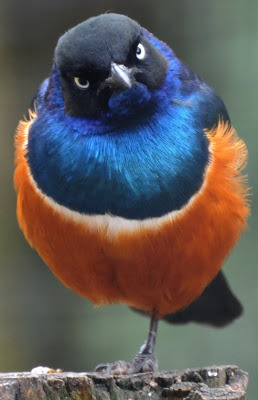 Stop killing my people!
Stop killing my people! Source: http://postcaption.com/uploads/bs/Superb-Starling_0.jpgWilliam Wood frets a little about frightening birds away with gunfire, or whether everyone had time or means to hunt, but he had little concern about the effects of hunting on avian populations.
Passenger Pigeons are a spectacular example of how unlimited shooting, as well as habitat destruction, can exterminate even the biggest flocks, but the pigeon is not the only New England bird to have gone extinct since European arrival. Heath Hen, Great Auk, Labrador Duck, and even Carolina Parakeet used to be found in New England. The parakeets were killed to prevent their predation on crops, but the others are gone because they tasted good, their eggs were collected to feed fishermen, or the birds themselves were easy to kill.
Some of those extinct birds had one more thing in common with the Ivory-billed Woodpecker and Whooping Cranes, the poster children of birds in peril. Their ranges were limited, and they had nowhere else to go. The Ivory-bill may or may not be gone, but the Whooping Crane is hanging on. At last we’ve realized that their habitat must be protected along with the birds.
___________
 * Jo Ann Butler is a naturalist, archaeologist, genealogist, and author of two historical novels set in Rhode Island during the lives of William and Mary Dyer: Rebel Puritan, and The Reputed Wife. Visit her websiteto learn more or to purchase the books.
* Jo Ann Butler is a naturalist, archaeologist, genealogist, and author of two historical novels set in Rhode Island during the lives of William and Mary Dyer: Rebel Puritan, and The Reputed Wife. Visit her websiteto learn more or to purchase the books. ___________ More information on Massachusetts birds: http://www.cctvcambridge.org/Mass_Audubon_Report_2011
Published on March 11, 2013 22:12
No comments have been added yet.



